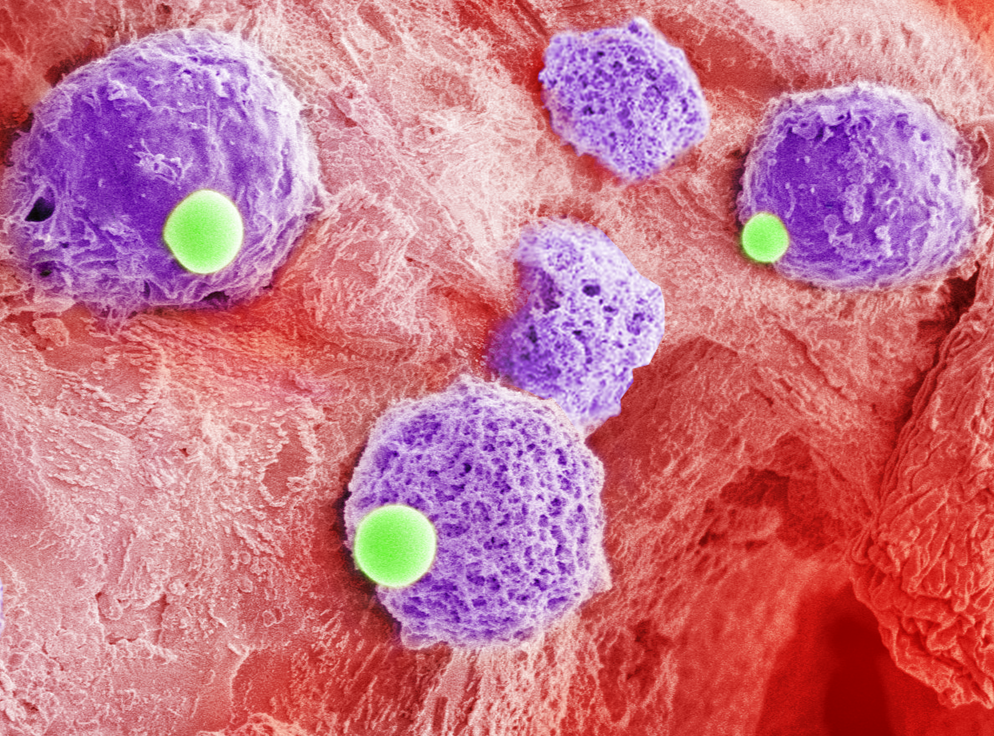Shackled together, stem cells and platelets may help us escape cancer, report UCLA scientists. In the scientists’ new study, the cancer is leukemia, and the defiant ones include a guide, a hematopoietic stem cell (HSC), and a drug carrier, an engineered platelet. The guide brings the duo into bone marrow, and the drug carrier delivers checkpoint inhibition therapy.
In experiments with mice that had acute myeloid leukemia, the UCLA team found that their unusual combination therapy halted the disease from developing any further. Of the mice that received the treatment, 87.5% were cured by 80 days after the combination cells were injected. Those mice also were all resistant to leukemia cells that were re-injected two months after the 80-day period.
Additional details appeared October 29 in the journal Nature Biomedical Engineering, in an article titled, “Conjugation of haematopoietic stem cells and platelets decorated with anti-PD-1 antibodies augments anti-leukaemia efficacy.” As the title indicates, the modified platelets were capable of delivering cancer immunotherapy because they were equipped with antibodies against programmed cell death protein 1 (PD-1), an immune checkpoint protein that studs the surface of T cells and guards against autoimmunity. By binding PD-1, checkpoint inhibitor drugs “release the brakes” on T-cell anticancer activity.
“Following intravenous injection into mice bearing leukemia cells, the HSC–platelet–aPD-1 conjugate migrated to the bone marrow and locally released aPD-1, significantly enhancing anti-leukemia immune responses, and increasing the number of active T cells, production of cytokines and chemokines, and survival time of the mice,” the articles authors indicated. “This cellular conjugate also promoted resistance to re-challenge with leukemia cells.”
This unusual immunotherapy approach could be used in concert with other therapies, such as chemotherapy and stem cell treatment, to improve their effectiveness,” notes the study’s senior author, Zhen Gu, Ph.D. a professor of bioengineering at the UCLA Samueli School of Engineering. Dr. Gu adds, however, the method would have to be tested and approved in human clinical trials before it could be incorporated in treatments for people with leukemia.
Acute myeloid leukemia is a cancer that starts in bone marrow and can spread to the bloodstream and other parts of the body. With a compromised immune system, a person with this type of leukemia could die from complications from other diseases.
As a treatment for leukemia, chemotherapy on its own is only moderately effective: Leukemia fails to go into remission in about 1 in 3 patients following chemotherapy, according to the American Cancer Society. And about half of people with the disease who do experience remission may have a relapse—typically within two years after treatment—usually because chemotherapy cannot reach cancer cells in bone marrow.
The UCLA-led research aimed to solve that problem by devising a method to deliver medicine directly into the bone marrow. The approach, termed “cell combination drug delivery,” is the first to link two different cells together for therapeutic purposes.
“This platelet part of the cell combination is like a delivery truck,” Dr. Gu explains. “We can package medicines or immune system boosters on the cell surface of platelets, and have them activated to unload once at the target site inside the body.”
The HSC part of the cell combination can find its way into the bone marrow through specific chemical signals. “The hematopoietic stem cells are like a homing signal to the bone marrow,” notes Quanyin Hu, Ph.D., a lead author of the paper and former doctoral student in Dr. Gu’s research group. “Once the stem cells guide the combo cells into the marrow, the platelets can be activated. They release immunotherapy cargoes inside the marrow to facilitate the body’s own defenses, in this case T cells, to kill leukemia cells.”
The researchers indicated that they plan to continue studying the approach as a potential therapy for leukemia and other diseases. They emphasized that by taking advantage of the homing capability of HSCs and in situ activation of platelets for the enhanced delivery of a checkpoint inhibitor, their cellular combination-mediated drug delivery strategy could significantly augment the therapeutic efficacy of checkpoint blockade.


